English [🇺🇸]
Let's talk about a trendy subject among surfers: waves!
There are different types of waves. Each has specific characteristics and will also provide different types of surf requiring different skills so we can ride them.
To define these characteristics, we have to consider variables such as the type of bottom, the location's depth, and the wind's intensity. In this way, we can define each wave's shape, size, and speed.
But before talking about the types of waves, it is vital to understand how waves are formed and what factors influence their formation.
How are waves formed?
Sea waves exist because, somewhere, something "pushed" the water, literally. But generally, sea wave formation (the waves we surf) starts far from the shore and begins by blowing the wind on the sea's surface. The wind hits the water, transferring energy to it, forming small ripples (between 1 and 2 cm). As the wind blows, these ripples grow in size, length, and speed.
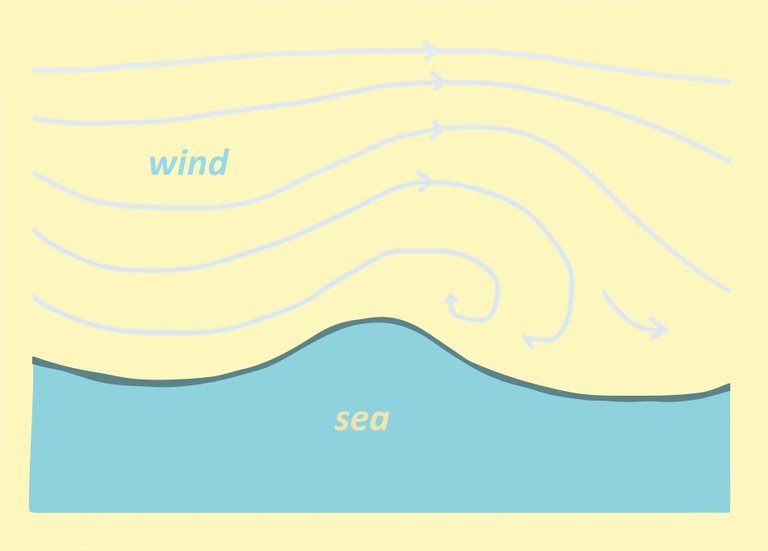
- The faster and more durable the wind, the greater the height of the wave.
- If the ripple formed is still tiny and the wind stops blowing, the waves disappear.
- And if the wind continues, the swell gets higher, longer, and faster until it forms the waves we know.
And yet, even if the wind stops, the wave continues to propagate, being able to travel for kilometers until it reaches the sand. For this to happen, the wind needs to blow for a while and travel a long distance on the surface, which is called a "fetch". For this reason, in a lagoon, there are no big waves like in the sea, for example, as there is not enough track or space for them to increase.
Generally, the greater the wind intensity, the greater the wave. When it gets close to the coast, with reduced depth, the wave's crest collides with the bottom and starts to break.
Another key point in wave formation is the type of bottom. It defines the characteristics of the wave, such as the breaking point. Calm down; we'll get there! For that, let's learn what the parts of the wave are.
Parts of the wave
The wave basically consists of three parts:
- the crest (or "lip"): the highest part of the wave
- the base: base of the structure that supports the wave
- and the breaking area: as the name implies, this is where the wave usually breaks (and when the surf usually kicks in!)

We can still mention here the wall, which is basically the part of the wave that remains standing, like a wall, usually when the tubes are formed. It is common for the drop to start at the crest, go down the wall (in big or hollow waves), and end at the base, where we position ourselves to start doing the maneuvers.
Why and how does a wave break?
They usually break due to decreasing depth. As the wave travels along the sea's surface towards the coast, the crest gets higher and higher, and the base gets closer to the bottom. In this area, the depth of the water decreases to the point where it is almost the same height as the wave (so by the height of a wave, we know how deep the water is). At that moment, the base begins to rub against the bottom and "breaks" the ripple. As a result, the crest is no longer supported and loses balance, leaning forward and breaking over the base until it falls.
That's why we usually don't see waves on the open seas, as the depth is great enough for this friction not to happen and the wave not to break. And when you look out to sea and see waves breaking, you can be sure there is a sandbar or a coral reef there. And of course, near the beach, they will also break.
OK, but what about the waveform?
When the wave arrives close to the shore, and when it breaks, it can break in several ways. And this will depend mainly on the type of bottom of the place. The most well-known waveforms are: "sliding" and "diving".
🌊 The sliding break
It happens on shallow and slightly inclined beaches, which causes the wave to break gradually and smoothly, even before getting closer to the coast. They are the famous full and chubby waves or the famous "marola" as we like to call it in Brazil. This type of wave is excellent for more relaxed and fun surfing, especially for beginners, as they are easier to catch and do not risk wiping out!
One of the main factors contributing to this type of wave, in addition to the type of seabed, is the onshore wind, which comes from the sea toward the land.

Surfer: Renata Diehl on a sliding wave| Photo: Fellipe Ditadi
🌊 The diving break
When the waves break diving, the famous tubes are formed. This is only possible when there is a drastic change of depth from one type of bottom to another, which can be characterized, for example, when the wave encounters a coral reef or a sandbar. The depth decreases so suddenly at that moment that the wave breaks out of nowhere and forms the tube.
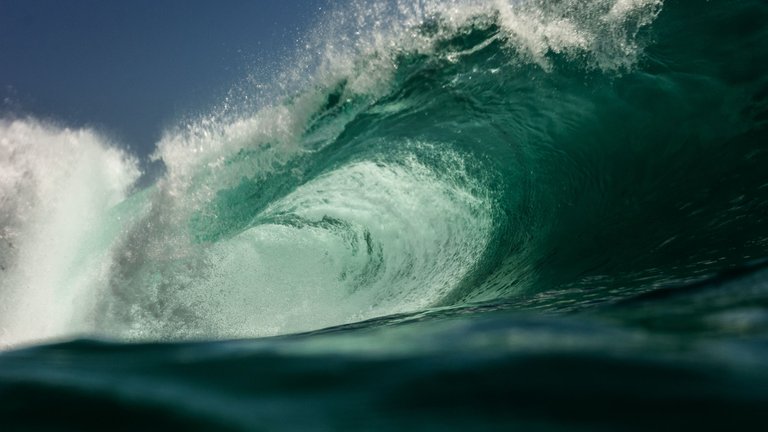
"Diving" wave. Photo by Emiliano Arano at Pexels
SO,
In other words, when it hits the shallow coral reef or sandbar, it's as if the bottom of the wave starts to brake. To conserve energy, the wave quickly gains height until the top travels faster than the bottom, causing the wave to break.
The wind that contributes to the incidence of this wave is the offshore wind, which comes from the land towards the sea, causing friction directly in the surf. This wind hits the waves head-on, holding them and making them stand longer.
Briefly, if the depth gradually decreases, the wave breaks weak and "fat". If it decreases sharply, it grows and breaks suddenly, forming the tube. The ideal for most surfers is an intermediate stage, creating the perfect wave. And speaking of wind, there's still the "sided" wind, which runs parallel to the beach and usually doesn't help and gets in the way, leaving everything in a mess.
To finish, there are several terms/slang used in surfing in relation to identifying different types of waves and each one of them.
And for you to know, here they are:
🌊 Beach Breaks
They are also called sand bottom waves. They are those that, as the name suggests, break in the sand. As the sand moves over time and according to currents, there can be variations in size, speed, height, and where the waves break (more or less close to shore). Most Brazilian beaches are beach breaks.
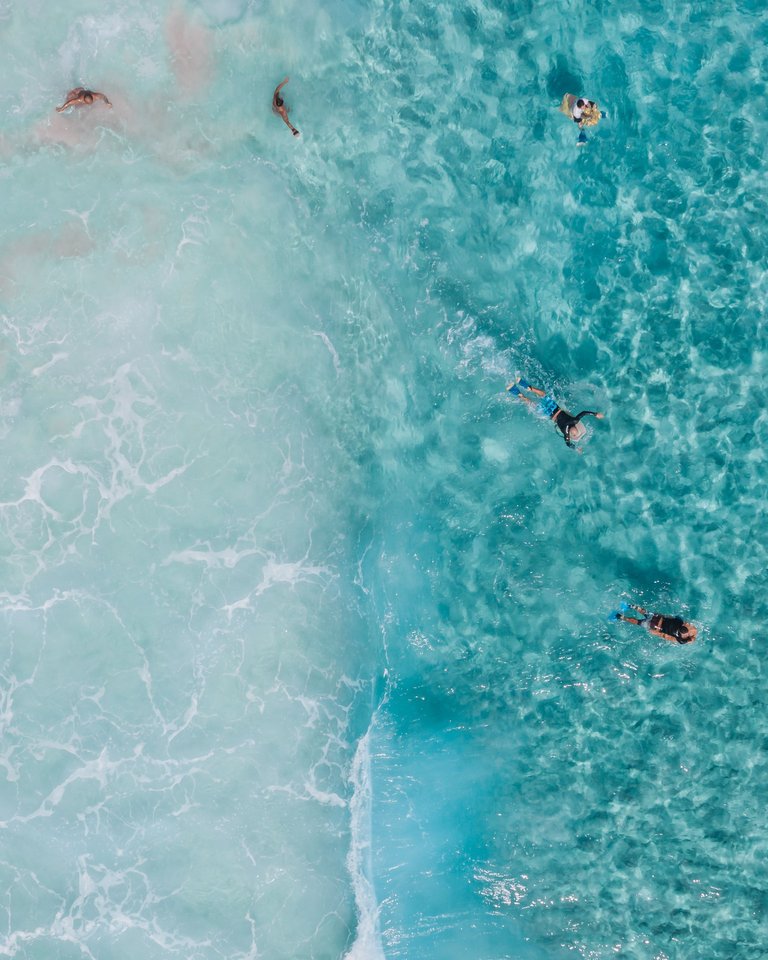
Beach break. Photo by Jess Loiterton at Pexels
These are the most suitable for beginners, as they are safer in cases of falls (better to fall on sand than on corals or rocks, right?). They are usually slower waves and of short duration. However, even if they are better for safety, beach breaks can have a change of peak (place on the beach where the waves break and are conducive to surfing) very often, as the sandy bottom is more vulnerable to variations, making it difficult to determine where the waves will break and what their formation point is.
🌊 Reef Breaks:
Reef breaks, or coral bottom waves, are those whose bottom is composed of reefs and corals. Waves are more stable and predictable than beach breaks, as the bottom doesn't change as easily. On the other hand, they are extremely dangerous in falls, as corals can be sharp and treacherous. So, they are not recommended for beginner surfers. The waves are faster and stronger, suitable for intermediate and experienced surfers.
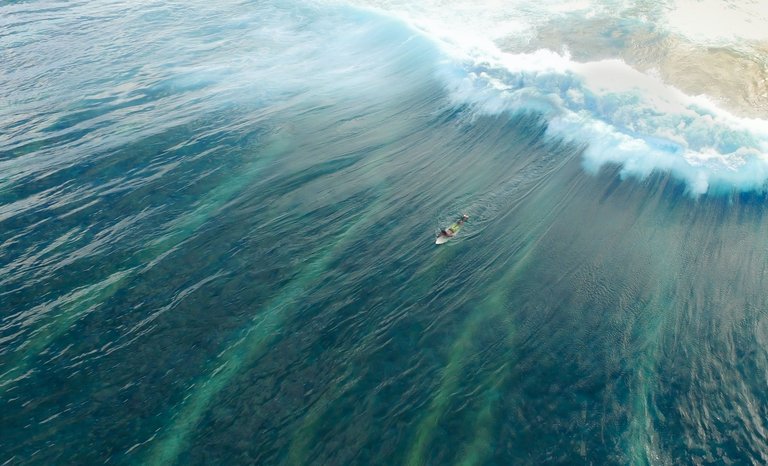
Reef break. Photo by Ishan at Pexels
🌊 Point Breaks:
A point break is a surf break where waves break over a stationary or semi-stationary point of land or rock. The waves typically peel or break consistently and predictably, providing long and rideable waves, making it a preferred choice for surfers of various skill levels.
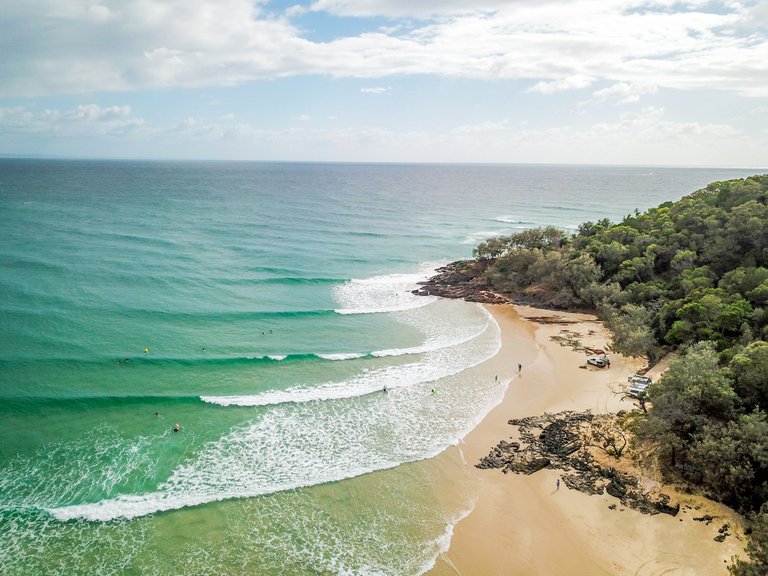
Point break. Photo by Daniel Jurin at Pexels
🌊 Crumbly:
It is a type of wave that is not very strong, ideal for those learning to surf. This is because they are not very steep and not very fast. But they can also be great for more experienced surfers, as their face is ideal for practicing maneuvers and perfecting yourself.
🌊 Green Waves:
These waves reach the beach and do not break, but it is still possible to ride them. These waves arrive at the coast still strong enough to continue propagating, but on a very shallow bottom, there is not enough friction for the crest to lose balance and break. That means they're challenging to catch!
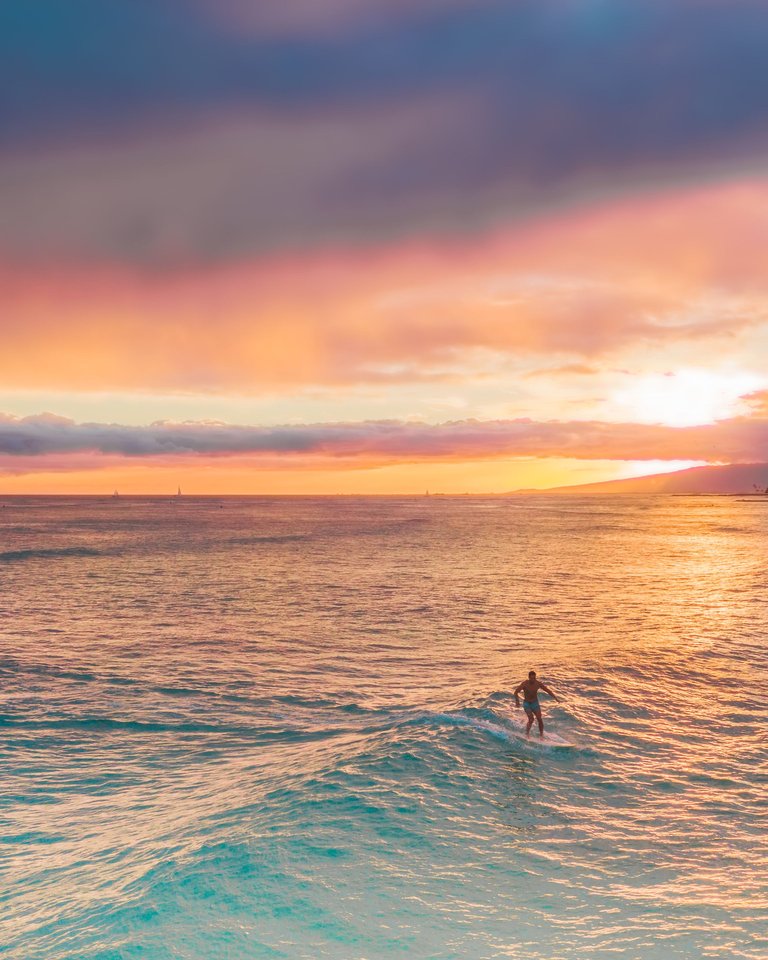
Photo by Jess Loiterton at Pexels
🌊 Rivermouth Waves:
It is a wave that forms when a river deposits sand on an already-formed sand bank. They are rare, but they are spectacular waves. It is possible to observe these waves where a river meets the sea.
🌊 Tubing:
The favored tube is a hollow wave and is one of the most sought-after by surfers. Anyone who has had the opportunity to surf one of them always describes it as an incredible experience, surrounded by water while still moving through the wave. For beginners, it's best to stay away from them. The idea is to continue gaining experience in more manageable waves and only then try your luck in a tube.
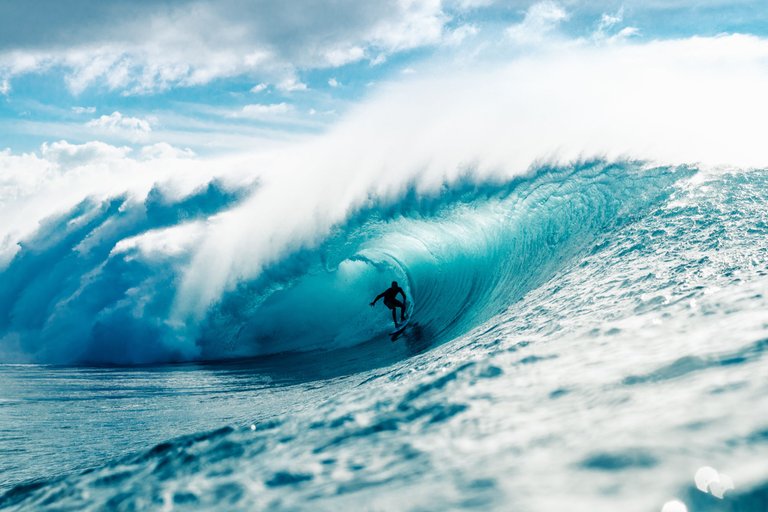
Photo by Kammeran Gonzalez-Keola at Pexels
🌊 Reforms:
It is a wave that does not have a constant shape, as it breaks and dies, then passes through deeper waters and breaks again when it finds the shallows. This happens precisely because of the changes in the bottom along the wave's path. It could be a sandbar or coral that makes this wave join the next one. It is common for more experienced surfers to surf the first part of the wave and leave the second part to less experienced surfers.
🌊 Closeouts:
The closeouts are those that break at once, not gradually. In addition, they create a large amount of foam when breaking. Therefore, it is not an ideal type of wave for surfing. They are waves that do not curve, and they do not have an open face for surfing (they do not open). It's important to recognize it to avoid that unavoidable wipeout!
Phew, lots of information! But the essentials you already know
There are different types of waves; some are more dangerous and should only be surfed by experienced surfers, while others are great opportunities for beginners to learn to surf or start training maneuvers.
Remember: it's important to know how to identify each so you know what to expect and, above all, if it's your time to face it. Surfing is a lot of fun and should always be done safely!
So, what's your favorite tipe of wave?
About me
Biologist, Photographer, Content Producer, and Community Builder. Please take a look at my introduction post to get to know me better.
My social networks:
- Personal Instagram – me, my husband, my cats, sustainability, biology curiosities, and adventures: @crisciacm
- Professional Instagram – surf, nature, and people photos: @crisciacesconettophoto
- Youtube Channel - surf videos: @crisciacesconetto
- My profile at Thatsgnar.ly - crisciacesconetto
- Twitter – Não sei o que fazer por lá, mas existe: @crisciacm
Português - BR [🇧🇷]
Vamos falar de um assunto bem popular entre surfistas: ondas!
Existem diferentes tipos de ondas, cada uma delas tem características específicas e que vão proporcionar também diferentes tipos de surf que exigem diferentes habilidades pra que a gente consiga pegá-las.
Para definir essas caraterísticas, temos que levar em conta variáveis como o tipo de fundo, a profundidade do local e a intensidade do vento. Dessa forma conseguimos definir o formato, tamanho e velocidade de cada onda, respectivamente.
Mas antes de falar dos tipos de ondas é importante entendermos como as ondas são formadas e quais fatores influenciam na sua formação.
Como as ondas são formadas?
As ondas do mar existem porque, em algum lugar, alguma coisa empurrou a água. Mas geralmente, o processo de formação das ondas do mar começa bem longe da praia e começa a partir do sopro do vento na superfície do mar. O vento bate na água, transferindo energia pra ela, formando pequenas ondulações (entre 1 e 2 cm). À medida que o vento continua soprando, essas ondulações crescem aumentando tamanho, comprimento e velocidade.
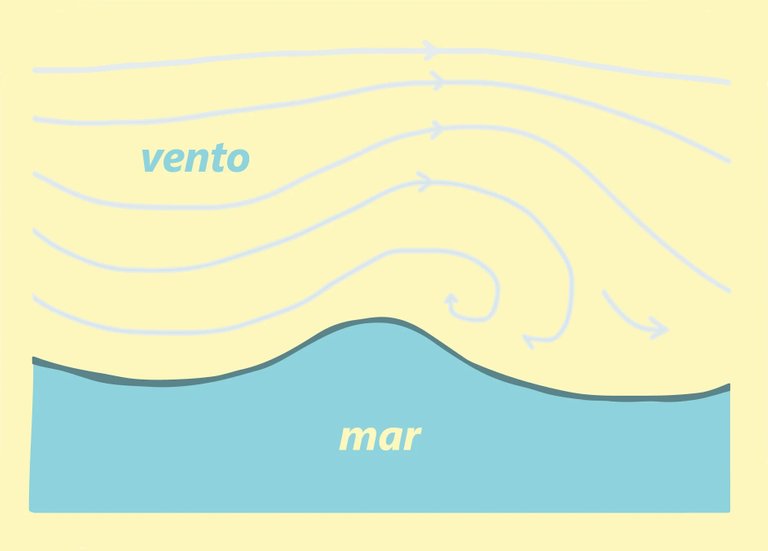
- Quanto mais veloz e durável for o vento, maior será a altura da onda.
- Se a ondulação formada ainda for pequena e o vento parar de soprar, as ondas somem com ele.
- E se o vento continuar, essa ondulação vai ficando mais alta, mais comprida e mais rápida até formar as ondas que conhecemos.
E ainda, mesmo se o vento parar, a onda continua se propagando, podendo viajar por quilômetros, até chegar na areia. Pra isso acontecer, o vento precisa soprar por um tempo e percorrer uma longa distância na superfície, que é chamada de pista. Por esse motivo, em uma lagoa, não existem ondas grandes como no mar, por exemplo, pois não há pista suficiente para que elas aumentem.
Como regra geral, quanto maior a intensidade do vento, maior será a onda. Quando chegam próximas a costa, com a profundidade reduzida, ocorre um choque da crista da onda com o fundo e ela começa a quebrar.
Outro ponto fundamental na formação das ondas é o tipo de fundo. Eles que definem as características da onda, como ponto de quebra. Calma, vamos chegar lá! Pra isso, vamos aprender agorinha quais são as partes da onda.
Partes da onda
A onda é composta basicamente por três partes:
- a crista (ou "lip"): parte mais alta da onda
- o cavado (ou base): base da estrutura que sustenta a onda
- e a área de rebentação: como o próprio nome já diz, é onde a onda, geralmente, se quebra (e quando geralmente o surf entra em ação!)
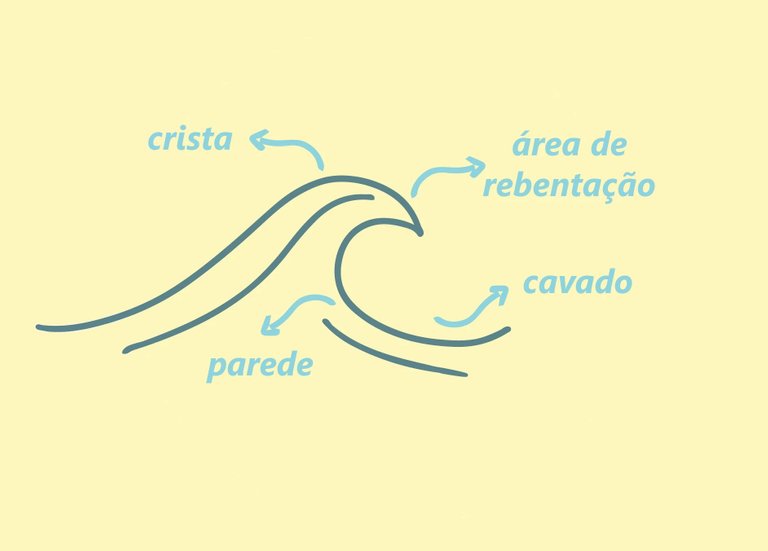
A gente ainda pode citar aqui a parede, que é basicamente a parte da onda que fica em pé, como uma parede mesmo, geralmente quando são formados os tubos. É muito comum o drop começar na crista, descer pela parede (em ondas grandes ou tubulares) e terminar na base, onde nos posicionamos pra começar a fazer as manobras.
Por que e como a onda quebra?
Elas se quebram devido à diminuição da profundidade. À medida que a onda vai percorrendo a superfície do mar em direção à costa, a crista vai ficando cada vez mais alta e o cavado cada vez mais perto da areia. É nessa área que a profundidade da água diminui a ponto de ter quase a mesma altura da onda (então pela altura de uma onda sabemos qual é a profundidade da água). Nesse momento, o cavado começa a entrar em atrito com a areia e freia a ondulação. Como resultado a crista não se sustenta mais e perde o equilíbrio, inclinando pra frente e quebra por cima do cavado até cair.
Por isso geralmente não vemos onda em alto mar, pois a profundidade é grande o suficiente para que esse atrito não aconteça e a onda não quebre. E quando você olha para o alto-mar e vê ondas se quebrando, pode ter certeza que ali tem um banco de areia, ou um recife de coral. E é claro que, perto da praia, elas também vão se quebrar.
Tá, mas e o formato da onda?
Quando a onda chega próxima da costa e no momento de quebrar, ela pode quebrar de várias formas. E isso vai depender principalmente do tipo de fundo do local. A formas de ondas mais conhecidas são: deslizante e mergulhante.
🌊 A quebra deslizante
Acontece em praias rasas e pouco inclinadas, o que faz com que a onda vá quebrando gradativa e suavemente, antes mesmo de chegar mais perto da costa. São as famosas ondas cheias e gordinhas ou a famosa marola como a gente gosta de chamar. Esse tipo de onda é ótimo pra um surf mais descontraído e divertido, principalmente para iniciantes, pois são mais fáceis de pegar e não correr o risco de tomar um caldo!
Um dos principais fatores que colaboram para esse tipo de onda, além do tipo do fundo do mar, é o vento maral, que vêm do mar em direção à terra.

Surfista: Renata Diehl numa onda deslizante. Foto de Fellipe Ditadi
🌊 Quebra mergulhante
quando as ondas quebram mergulhando, são formados os famosos tubos. Isso só é possível onde há uma mudança muito drástica de um tipo de fundo para outro, o que pode ser caracterizado por exemplo quando a onda encontra um recife de coral ou um banco de areia no caminho. Nesse momento, a profundidade diminui tão repentinamente, que a onda quebra do nada e forma o tubo.

Quebra mergulhante. Foto de Emiliano Arano no Pexels
ENTÃO,
Em outras palavras, ao atingir a bancada rasa de coral ou o banco de areia, é como se a parte inferior da onda começasse a frear. Para conservar sua energia, a onda rapidamente começa a ganhar altura até que a parte superior comece a se deslocar mais rápido do que a parte inferior, fazendo com que a onda quebre.
O vento que contribui para a incidência dessa onda é o vento terral, aquele que vem da terra em direção ao mar, causando atrito diretamente na arrebentação. Esse vento bate de frente nas ondas segurando-as e fazendo com que elas fiquem em pé por mais tempo.
Resumidamente, se a profundidade diminui aos poucos, a onda quebra fraca e gorda. Se diminui bruscamente, ela cresce e quebra de repente formando o tubo. O ideal para a maioria dos surfistas é um estágio intermediário, formando a onda perfeita. E falando em vento, ainda tem o vento lateral, que corre paralelamente a praia e geralmente não ajuda e só atrapalha, deixando tudo uma bagunça.
Pra terminar, existem vários termos/gírias usados no surf pra generalizar e identificar vários tipos de ondas diferentes e cada uma delas.
E pra você ficar por dentro, aqui vão elas:
🌊 Beach Breaks
Também chamadas de ondas de fundo de areia. São aquelas que, como o próprio nome sugere, quebram na areia. Como a areia se move ao longo do tempo e de acordo com as correntes, podem haver variações no tamanho, velocidade, altura e local onde as ondas quebram (mais ou menos perto da costa). A maior parte das praias brasileiras são beach breaks.

Beach break. Foto de Jess Loiterton no Pexels
Essas são as mais indicadas para os iniciantes, pois são mais seguras em casos de quedas (melhor cair na areia do que em corais ou pedras né?). Normalmente são ondas mais lentas e de curta duração. Porém, mesmo que sejam melhores pela segurança, as beach breaks podem ter mudança de pico (lugar na praia onde as ondas quebram e é propício ao surf) muito frequentemente, pois o fundo de areia é mais vulnerável à variações, sendo difícil determinar onde as ondas quebrarão e qual o seu ponto de formação.
🌊 Reef Breaks:
As reef breaks ou ondas fundo de coral (reef = recife de coral, em inglês) são aquelas cujo fundo é composto de recifes e corais. As ondas são mais estáveis e previsíveis em comparação às beach breaks, já que o fundo não se altera com tanta facilidade. Em compensação, extremamente perigosas em casos de quedas, pois os corais podem ser afiados e traiçoeiros. Então, não são recomendadas para surfistas iniciantes. As ondas são mais rápidas e fortes, sendo indicadas para surfistas intermediários e experientes.

Reef break. Foto de Ishan no Pexels
🌊 Point Breaks:
Um point break é um local onde as ondas encontral com uma "ponta" na terra/costa e por isso quebram. As ondas normalmente quebram de forma consistente e previsível, proporcionando ondas longas e surfáveis, tornando-a uma escolha preferida para surfistas de vários níveis de habilidade.

Point break. Foto de Daniel Jurin no Pexels
🌊 Crumbly:
É um tipo de onda que não é muito forte, ideal para quem está aprendendo a surfar. Isso se deve ao fato de não serem muito íngremes e nem muito rápidas. Mas também podem ser ótimas para os surfistas mais experientes, pois a face delas é ideal para praticar manobras e se aperfeiçoar.
🌊 Green Waves:
Também chamadas de ondas verdes, são ondas que chegam à praia e não quebram, mas ainda sim é possível pegá-las. Basicamente essas ondas chegam à costa ainda com força o suficiente para continuar se propagando, mas que num fundo pouquíssimo inclinado, não há atrito o suficiente para que a crista perca o equilíbrio e quebre. Isso não quer dizer que sejam fáceis de pegar!

Foto de Jess Loiterton no Pexels
🌊 Rivermouth Waves:
É um tipo de onda que se forma quando um rio deposita areia em um banco de areia já formado. São raras, mas são ondas espetaculares. É possível observar essas ondas onde tem o encontro de um rio com o mar.
🌊 Tubing:
O popular tubo, é uma onda oca, e é uma das mais procuradas por surfistas. Quem já teve a oportunidade de surfar em uma delas sempre descreve como uma experiência incrível, estar rodeado pela água ao mesmo tempo em que continua se movendo pela onda. Para os iniciantes, o melhor é ficar longe delas. O ideal é continuar ganhando experiência em ondas mais fáceis para depois tentar a sorte em um tubo.

Foto de Kammeran Gonzalez-Keola no Pexels
🌊 Reforms:
É um tipo de onda que não tem um formato constante, pois ela quebra e vai morrendo, daí passa por águas mais fundas e quebra novamente quando encontra o raso. Isso se dá exatamente pelas variações do fundo ao longo do caminho pelo qual a onda vai passando. Pode ser um banco de areia ou coral que fazem essa onda se juntar a próxima. É bem comum que os surfistas mais experientes surfem a primeira parte da onda e deixem a segunda parte para os menos experientes.
🌊 Closeouts:
As closeouts ou fechadeiras são aquelas que quebram de uma vez, e não aos poucos. Além disso elas criam uma grande quantidade de espuma ao quebrar. Por isso, ela não é um tipo de onda ideal para o surf. São ondas que não fazem a curva e elas não tem uma face aberta para o surf (elas não abrem). É importante reconhecê-la para evitar aquele caldo quase certo!
Ufa, muita informação! Mas o essencial você já sabe
Deu pra ver que existem diferentes tipos de ondas sendo que algumas são mais perigosas e devem ser surfadas apenas por surfistas experientes, enquanto outras são ótimas oportunidades para iniciantes aprenderem a surfar ou começarem a treinar manobras.
Lembre-se: é importante saber identificar cada uma delas, assim você sabe o que esperar e, principalmente, se é sua hora de enfrentá-la. Surfar é divertidíssimo e deve sempre ser feito com segurança!
E aí, me diz, qual sua onda preferida?
Sobre mim
Bióloga, Fotógrafa, Produtora de Conteúdo e Construtora de Comunidades. Dá uma olhada no meu post de introdução pra me conhecer melhor.
Minhas redes sociais:
- Instagram pessoal – eu, meu marido, meus gatos, sustentabilidade, curiosidades biológicas e aventuras: @crisciacm
- Instagram profissional – fotos de surf, natureza, e pessoas: @crisciacesconettophoto
- Canal no Youtube - videos de surf: @crisciacesconetto
- Meu perfil no Thatsgnar.ly - crisciacesconetto
- Twitter – I don't know what to do there, but it exists: @crisciacm
Congratulations @crisciacm! You have completed the following achievement on the Hive blockchain And have been rewarded with New badge(s)
Your next target is to reach 2000 upvotes.
You can view your badges on your board and compare yourself to others in the Ranking
If you no longer want to receive notifications, reply to this comment with the word
STOPCheck out our last posts:
Obrigado por promover a comunidade Hive-BR em suas postagens.
Vamos seguir fortalecendo a Hive
Your post was manually curated by @michupa.
Delegate your HP to the hive-br.voter account and earn Hive daily!
🔹 Follow our Curation Trail and don't miss voting! 🔹